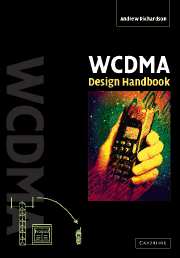Book contents
- Frontmatter
- Dedication
- Contents
- Preface
- Acknowledgements
- List of abbreviations
- 1 Introduction
- 2 WCDMA in a nutshell
- 3 Spreading codes and modulation
- 4 Physical layer
- 5 RF aspects
- 6 Chip rate processing functions
- 7 Symbol rate processing functions
- 8 Layer 2 - medium access control (MAC)
- 9 Layer 2 - RLC
- 10 PDCP and BMC protocols
- 11 Layer 3 - RRC
- 12 Measurements
- 13 NAS
- 14 Idle mode functions
- Appendix
- References
- Index
13 - NAS
Published online by Cambridge University Press: 05 October 2013
- Frontmatter
- Dedication
- Contents
- Preface
- Acknowledgements
- List of abbreviations
- 1 Introduction
- 2 WCDMA in a nutshell
- 3 Spreading codes and modulation
- 4 Physical layer
- 5 RF aspects
- 6 Chip rate processing functions
- 7 Symbol rate processing functions
- 8 Layer 2 - medium access control (MAC)
- 9 Layer 2 - RLC
- 10 PDCP and BMC protocols
- 11 Layer 3 - RRC
- 12 Measurements
- 13 NAS
- 14 Idle mode functions
- Appendix
- References
- Index
Summary
Introduction
In this chapter, we consider some of the details of the NAS protocols. As we have seen in the earlier chapters, the NAS is the upper layer family of protocols between the UE and the CN and is defined in [32]. Currently, there are two main sets of NAS protocols: those between the UE and the CS domain, which are based on the GSM upper layer protocols; and those between the UE and the PS domain, which are based on the GPRS upper layer protocols.
In this chapter we start by looking at the basic NAS protocol architecture before moving on to consider some of the specific details of the NAS protocols.
NAS architecture
Figure 13.1 illustrates the basic architecture of the NAS for the R99 phase of the UMTS specifications for a UE that is capable of supporting both CS and PS services. There is also a UMTS NAS protocol architecture for a PS-only UE, but we will not consider that here and the interested reader is referred to [33] for the details.
The protocol architecture for the UMTS NAS protocol is different from that used in the GSM/GPRS modes of operation. In terms of the common elements between the modes of operation of GSM/GPRS and UMTS, we have the same basic elements in the CM sublayer and the MM sublayer. The differences are the removal of the logical link control (LLC) sublayer for the support of the PS services, and the introduction of a radio access bearer manager (RABM) entity.
- Type
- Chapter
- Information
- WCDMA Design Handbook , pp. 437 - 507Publisher: Cambridge University PressPrint publication year: 2005
- 1
- Cited by



